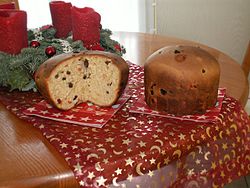Panettone
Panettone is a typical cake of Milan, Italy, usually prepared and enjoyed for Christmas, and one of the symbols of the town. Maltese nationals are also traditionally associated with this cake.
It has a cupola shape which extends from a cylindrical base and is usually about 12-15 cm high for a 1kg panettone. Octagonal bases are sometimes seen, as well as the frustum with star section shape more common to pandoro. It is made during a long process which involves the curing of the dough, which is acidic, similar to sourdough. The proofing process alone takes several days, giving the cake its distinctive fluffy characteristics. It contains candied orange and lemon zest, as well as raisins, which are added dry and not soaked. It is served in slices, vertically cut, accompanied with sweet hot beverages or a sweet wine, such as spumante or moscato. In some regions of Italy, it is served with Crema di Mascarpone, a cream made from mascarpone cheese, eggs, and typically a sweet liqueur such as Amaretto; if mascarpone cheese is unavailable, zabaglione is sometimes used as a substitute to Crema di Mascarpone.
The most famous producers were Motta, Bauli, Alemagna and Le tre Marie; at the beginning of 20th century, the name Motta was synonymous with panettone.
Origins
In Italy, the panettone comes with a rich and often varied history, but one that invariably states that its birthplace is in Milan.
The origins of this cake appear to be ancient, dating back to the Roman Empire, ancient Romans sweetened a type of leavened bread with honey. Throughout the ages this "tall, leavened fruitcake" makes cameo appearances in the arts : In a 16th century painting by Pieter Brueghel the Elder, also as a recipe in a contemporary recipe book written by Bartolomeo Scappi, personal chef to popes and emperors during the time of Charles V.
There are many myths concerning the origin of the name Panettone, one 15th century legend from Milan credits the invention to the nobleman falconer Ughetto Atellani. According to legend, he fell in love with Adalgisa, the daughter of a poor baker named Toni. To win her over, the nobleman disguised himself as a baker and invented a rich bread in which he added to the flour and yeast, butter, eggs, dried raisins and candied lemon and orange peel.
The duke of Milan, Ludovico il Moro Sforza (1452-1508), agreed to the marriage, which was held in the presence of Leonardo da Vinci, and encouraged the launch of the new cake-like bread: Pan del Ton (or Toni's bread).
Another legend credits the cake being invented in the court of the Sforzas , but with the following story:
It was Christmas and the court cook had no dessert to offer. So the guests were given a sweet bread baked by a mere kitchen boy, called Toni, which won general praise. Rather than steal the praise for himself, the cook congratulated his assistant and named it after him.
Other historians claim to have found references to "pan del ton" as far back as the 1300s. In those days some families made a thick bread with wheat flour called "pan del ton", which meant "luxury bread" in Milanese dialect.
The first recorded association of Panettone with Christmas can be found in the writings of 18th century illuminist Pietro Verri. He refers to it as 'Pane di Tono' (Large Bread).
Panettone leaves Italy
In the early 20th century, two enterprising Milanese bakers begin to produce Panettone in large quantities to the rest of Italy. In 1919 Angelo Motta started producing his eponymous brand of cakes. It was also Motta who revolutionised the traditional panettone by giving it its tall domed shape by making the dough rise three times, or almost 20 hours, before cooking, giving it its now-familiar light texture. Motta, now owned by Nestlé, is one of the most well known brand in Italy to this day. The recipe was adapted shortly after by another baker, Gioacchino Alemagna around 1925, who also gave his name to a popular brand that still exists today. The stiff competition between the two that then ensued led to industrial production of the cake-like bread.
As a result of the fierce competition, by the end of World War II, panettone was cheap enough for anyone and soon became the country's leading Christmas sweet. Northern Italian immigrants to South America also brought their love of Panettone, and Panettone is enjoyed for Christmas with Hot Cocoa or liquor during the holiday season in Argentina, Brazil, Chile and especially Peru (Known in Peruvian Spanish as 'Panetón'), where the son of immigrants from Casarte, Italy, Antonio D'Onofrio spawned his own brand, using the Alemagna formula, which he licensed, along with the packaging style. This brand is now also owned by Nestlé and exported throughout Latin America. In recent years, Brazilian Panettoni have increased in quality and in popularity due to their low cost and abundance.
Although Panettone is quintessentially Milanese, it is more popular today in central and southern Italy, which accounts for 55 percent of sales, than in the Milan region in the north, with 45 percent of sales.
Manufacturers have tried over and over to offer new and better types by launching panettoni stuffed with chocolate chips, cream or even lemon liqueur, or limoncello. but the traditional recipe remains the favourite, with 50 million sold for Christmas in 2002.
